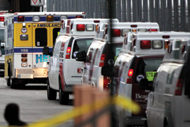FEMA’s 2016 National Preparedness Report shows health care on right path
The Federal Emergency Management Agency (FEMA) released its 2016 National Preparedness Report, which evaluates emergency preparedness among individuals, communities, private and nonprofit sectors, faith-based organizations and all levels of government. FEMA reported on key findings in five areas: prevention, protection, mitigation, response and recovery.
Regarding health care and public health sectors, the report states, “Planning; public health, health care and emergency medical services; and risk and disaster resilience assessment are three core capabilities in which the nation has developed acceptable levels of performance for critical tasks, but that face performance declines if not maintained and updated to address emerging challenges.”
FEMA cites the United States’ 2014 Ebola response as an example, stating that although federal, state and local health partners began addressing challenges such as personal protective equipment for health care workers and medical countermeasures, the presence of the outbreak itself highlights the need to sustain and build capabilities to counter other infectious outbreaks.
ASPR issues Zika planning resources for health care providers, coalitions
The Department of Health & Human Services’ Assistant Secretary for Preparedness and Response has issued resources to help health care providers and coalitions plan for a real or potential Zika virus outbreak.
“A Zika outbreak is unlikely to result in large numbers of acutely ill patients needing simultaneous care, making surge planning for Zika unique from that of conventional disaster events, including those with an infectious disease component (e.g., pandemic influenza, Ebola),” the resource guide states. “In contrast, the known and suspected complications of Zika infection (including Guillain-Barré syndrome, microcephaly and other neurological disorders) are likely to disproportionately affect certain patient populations, most notably pregnant women and their developing fetuses. Treatment of these complications will likely require the participation of health care specialties and social services that may have limited experience with preparedness activities.”
CDC releases toolkit to reduce risk of Legionella
The Centers for Disease Control and Prevention (CDC) released a new toolkit to prevent Legionnaires’ disease outbreaks. The toolkit builds off of ASHRAE 188: Legionellosis: Risk Management for Building Water Systems.
The toolkit provides an easy-to-understand interpretation of ASHRAE Standard 188, as well as worksheets, checklists and scenarios of common water-quality problems. It also contains special sections and considerations for health care facilities.
In the last year, about 5,000 people were diagnosed with Legionnaire’s disease and more than 20 outbreaks were reported to the CDC. The most common source of building-associated Legionnaires’ disease outbreaks was drinkable water (56 percent), such as water used for showering, followed by cooling towers (22 percent), and hot tubs (7 percent).
House members call for flexible payment rule for hospital outpatient facilities
A bipartisan group of 235 House members urged the Centers for Medicare & Medicaid Services to provide flexibility in the implementation of the Medicare payment reductions for new off-campus hospital outpatient departments (HOPD) under the Bipartisan Budget Act to protect patients’ access to care. Specifically, they said the site-neutral payment reductions under Section 603 of the Act should not affect existing off-campus HOPDs that relocate, rebuild, change ownership or types of services, and should not affect services provided by a dedicated emergency department. They also urged the agency’s regional offices to use the rule of “reasonable proximity” when evaluating on-campus status.
Preparedness bill clears House panel with AHA-backed provision
The House Energy and Commerce Committee today approved the Strengthening Public Health Emergency Response Act (H.R. 3299) with a provision supported by the American Hospital Association (AHA) that would require the Government Accountability Office to report on state, local and hospital preparedness programs. The Department of Health & Human Services’ Hospital Preparedness Program (HPP) is the primary federal program for hospital emergency preparedness.
The AHA also urged Congress to fully fund the program at the authorized level of $374.7 million, noting that appropriations have been reduced by more than 50 percent since the program began.
Visual triggers increase hand-hygiene compliance, study says
Unpleasant images may motivate hospital staff to comply with hand-hygiene guidelines, according to a new study that will be presented at the Association for Professionals in Infection Control and Epidemiology’s annual conference June 11.
The infection control team at Henry Ford Health System in Detroit used images of bacterial growth to provoke feelings of disgust. They tested the images on hospital units that had low hand-hygiene compliance rates. Compliance in these units increased by between 11 and 46 percent in units in which the study was conducted.
“Hospital staff wanted to wash their hands after looking at the book and picturing similar contamination on their own skin,” said Ashley Gregory, MSL (ASCP), an infection prevention specialist who co-led the project.
NFPA releases updated Emergency Evacuation Planning Guide for People with Disabilities
The National Fire Protection Association (NFPA) released the second edition of its Emergency Evacuation Planning Guide for People with Disabilities. The guide is free and accessible online, and features updated statistics, graphics, photos and links. It also includes an expanded and more detailed checklist for planning an evacuation process.
“Accessibility among the disabled community is a relatively recent subject that we’ve begun to address in fire and building codes, but it’s one we must continue to proactively focus on, so that we can fully meet the safety needs of people with disabilities,” says Allan Fraser, senior specialist for NFPA’s Building Fire Protection division. “Moving forward, we plan to update the guide more frequently with timely updates and information that reflect the continually changing and evolving built environments in which we all work and live.”





